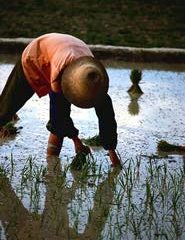Life Sciences and Chemistry
Articles and reports from the Life Sciences and chemistry area deal with applied and basic research into modern biology, chemistry and human medicine.
Valuable information can be found on a range of life sciences fields including bacteriology, biochemistry, bionics, bioinformatics, biophysics, biotechnology, genetics, geobotany, human biology, marine biology, microbiology, molecular biology, cellular biology, zoology, bioinorganic chemistry, microchemistry and environmental chemistry.

China leads GM revolution
Government funding puts Chinese plant biotechnology second only to US
While westerners vacillate about the risks and benefits of genetically modified (GM) crops, China is embracing the technology. A new survey shows that the Chinese are working on more plant biotechnology products than anyone outside North America1.
Chinese research institutes claim to have developed 141 GM plants, 65 of which have been approved for release into the environment. Scott Rozelle, an agricultura

Chemical industry helped by small invisible tube
Chemists at Utrecht University have developed a catalyst for fine chemistry. Tiny tubes of graphite are the carrier for this catalyst. PhD student Tijmen Ros successfully tested the catalyst with a standard reaction. Fellow researchers are now making the catalyst suitable for the production of cinnamon alcohol, an aromatic substance and flavouring.
According to the researchers from Utrecht, carbon nanofibres will replace active carbon as a carrier for catalysts. Carbon nanofibres are small t

Gene for neat repair of DNA discovered
Researchers from the Erasmus University in Rotterdam have demonstrated that a gene helps in the neat repair of DNA. Without this gene the body would repair damaged DNA in a careless manner more often. This causes new damage, which can lead to cancer.
The careless repair of damaged DNA can cause mutations and can result in cancer. Cell biologists from the Erasmus University in Rotterdam studied the repair of double strand breaks. Such breaks can for example arise following radiotherapy.
T

Life in a frozen environment – What´s in it for us?
Life on the moons of Jupiter, and a source of healthy polyunsaturated fatty acids and low temperature enzymes that could even make washing powders work at low temperatures: The microbes that live in Antarctic sea ice may hold the answers to a host of everyday applications as well as revealing how life forms might be able to exist on frozen planets. One of those interested in sea ice and the life forms it supports is Dr David Thomas of the University`s School of Ocean Sciences. He is presently the on

An intelligent combination of mathematics and cell biology could spell death to brain tumours
Combining two separate observations of cells in brain tumours could enable doctors to improve the success rate of radiotherapy. Speaking today (23 January) at the Institute of Physics Simulation and Modelling Applied to Medicine conference in London, chemical engineer Dr Norman Kirkby from the University of Surrey will explain how using the correct time intervals between a sequence of low dose radiotherapy sessions could increase the chance of curing brain cancers that tend to resist treatment.

’Eau de dad’ woos women
Genes mean ladies like friends and partners that smell like their father.
Bachelors – ditch the Old Spice and don your prospective father-in-law’s clothes. Women prefer the scent of their dad, a study shows, and may choose their friends and partners accordingly.
Nervous new boyfriends can live or die by the nod of a date’s daunting dad. But Carole Ober and her team at the University of Chicago in Illinois have found a more fundamental fatherly influence: women prefe